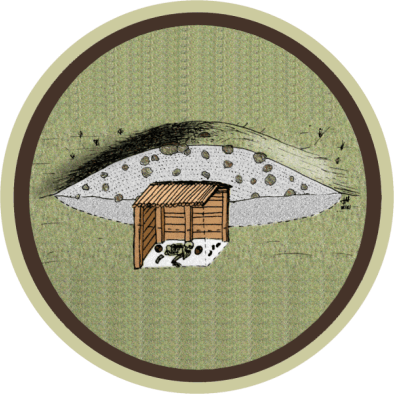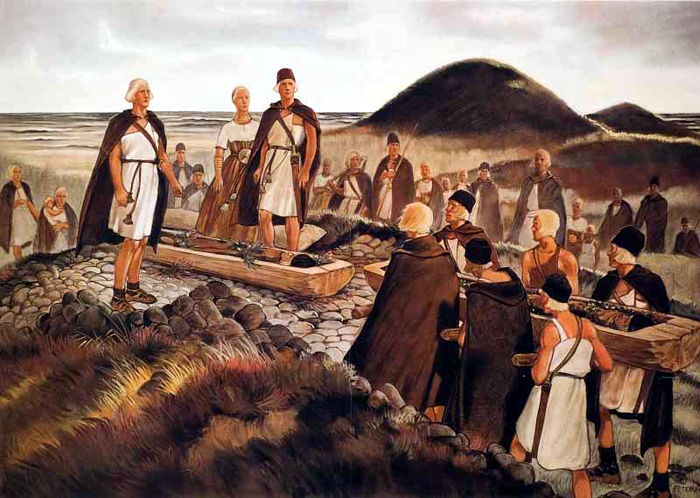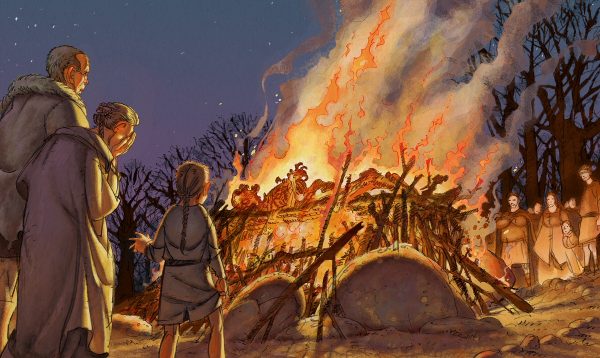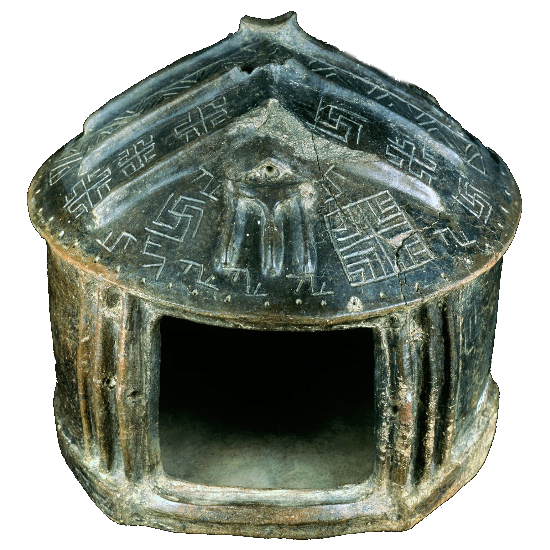BURIALS

Burial as a custom is not unique to the Indo-European cultures. Humans have been burying their dead since shortly after the origin of the species. Burial is often seen as indicating respect for the dead. It has been used to prevent the odor of decay, to give family members closure and prevent them from witnessing the decomposition of their loved ones, and in many cultures it has been seen as a necessary step for the deceased to enter the afterlife or to give back to the cycle of life.
This custom in Europe may date back as far as 100 000 BC. Evidence suggests that the Neanderthals were the first human species to practice burial behavior and intentionally bury their dead, doing so in shallow graves along with stone tools and animal bones.
Throughout Scandinavia, there are many remaining tumuli in honour of Viking kings and chieftains, in addition to runestones and other memorials. Some of the most notable of them are at the Borre Mound Cemetery in Norway, at Birka in Sweden and Lindholm Høje, and Jelling in Denmark. A prominent tradition is that of the ship burial, where the deceased was laid in a boat or a stone ship and given grave offerings in accordance with his earthly status and profession, sometimes including sacrificed slaves. Afterwards, piles of stone and soil were usually laid on top of the remains in order to create a tumulus. Additional practices included sacrifice or cremation, but the most common was to bury the departed with goods that denoted their social status.
The ancient Egyptians developed an intricate transmigration-of-soul theology, which prohibited cremation. This was also widely adopted by Semitic peoples. The Babylonians, according to Herodotus, embalmed their dead.
Early Persians practiced cremation, but this became prohibited during the Zoroastrian Period. Phoenicians practiced both cremation and burial. From the Cycladic civilisation in 3000 BC until the Sub-Mycenaean era in 1200 – 1100 BC, Greeks practiced inhumation. Cremation appeared around the 12th century BC, constituting a new practice of burial, probably influenced by Anatolia (for example in Iliad Patroclus has been cremated). Until the Christian era, when inhumation again became the only burial practice, both combustion and inhumation had been practiced, depending on the era and location. Romans practiced both, with cremation being the most popular form until the later imperial period.
Interment cultures

Yamna Culture (3300 BC)
Corded Ware Culture (2900 BC)
Catacomb Culture (2800 BC)
Catacomb burials are occasionally covered with Kurgan stelae. This practice was also common in the Yamnaya Culture. Some three hundred stelae have been found from the Yamnaya Culture and the Catacomb Culture.
Poltavka Culture (2700 BC)
This culture is ancestral to Indo-Iranians.
Abashevo Culture (2500 BC)
Afanasievo Culture (2500 BC)
Kiukainen Culture (2400 BC)
This might be the first Indo-European culture of Finland and Estonia.
Bell Beaker Culture (2300 BC)
Potapovka Culture (2000 BC)
Several Potapovka kurgans were constructed on top of earlier Poltavka kurans, which they destroyed. According to David W. Anthony, this is hardly accidental, testifying to a "symbolic connection" between the Poltavka and Potapovka people. An interesting feature of the Potapovka grave is the replacement of the head of the decapitated individual with that of a horse. This practice has been compared with an account in the Vedas of how the Aśvins replaced the head of Dadhichi, son of Atharvan, with that of a horse, so that he could reveal the secret of the sacred drink.
Sintashta Culture (1800 BC)
Tarim Mummies (1800 BC)
Srubnaya Culture (1800 BC
Nordic Bronze Age (1700 BC)
Associated with Nordic Bronze Age settlements are burial mounds and cemeteries with interments including oak coffins and urn burials. Other settlement associations include rock carvings or bronze hoards in wetland sites.
Russia (1500 CE)
That the vast majority of the Russian population was not Christian back in the fifteenth century would be proven by archaeology: according to Vlasov, mound (kurgan) burials, which do not reflect Christian norms were "a universal phenomenon in Russia up to the fifteenth century" and persisted into the 1530s.
Hinduism
Apart from the cremation method there are large sects in Hinduism which follow burial of the dead. The preparatory rituals are more or less similar to cremation viz, washing the body, applying vibuthi or chandam on the forehead of the deceased etc, but instead of cremating, the deceased is buried. The body is either placed in sleeping position or in some Shaivite and tribal traditions is in sitting position legs folded and arms resting on the thigh simulating meditative position. The burial pit is prepared in the community burial ground called Shamshana, usually situated outside the city or village. Some affluent will bury their dead in the own field. The burial pit for sleeping position is generally three feet width and six feet in length and for sitting position it is three feet by three feet. As a thumb rule in all the sects invariable the saints are buried in sitting position in a separate place where later on a Samadhi is built which becomes a place of worship.
Cremation cultures

Vedic Hinduism (2000 BC)
Cremation in India is first attested in the Cemetery H Culture (from 1900 BC), considered the formative stage of Vedic civilization. The Rigveda contains a reference to the emerging practice, in RV 10.15.14, where the forefathers "both cremated (agnidagdhá-) and uncremated (ánagnidagdha-)" are invoked. The bones were stored in painted pottery burial urns. This is completely different from the Indus civilization where bodies were buried in wooden coffins. The urn burials and the "grave skeletons" were nearly contemporaneous.
Hittites (1900 BC - 800 BC)
When someone dies, everyone (adults and young) take away their drinking-straw and begin to wail. Death is ritualised by killing an ox and possibly also a billy-goat. The body of the deceased is burnt on the second day after death. On the third day, the bones are removed from the pyre and taken to the tomb (É.NA) and the rite of conciliation (lilauwar) is performed. From this moment on, the deceased was represented by a statue[1].
Gauls (57 BC)
A funeral, among these people, is particularly spectacular. A great fire is built and everything for which the deceased cared, even animals, is thrown into it. Until a generation ago, Caesar says, they also burned slaves and dependents.
Germanic and Norse Cultures (500 CE)
In early Roman Britain, cremation was usual but diminished by the 4th century. It then reappeared in the 5th and 6th centuries during the migration era, when sacrificed animals were sometimes included with the human bodies on the pyre, and the deceased were dressed in costume and with ornaments for the burning. That custom was also very widespread among the Germanic peoples of the Northern continental lands from which the Anglo-Saxon migrants are supposed to have been derived, during the same period. These ashes were usually thereafter deposited in a vessel of clay or bronze in an "urn cemetery". The custom again died out with the Christian conversion of the Anglo-Saxons or Early English during the 7th century, when Christian burial became general.
Slavs (until 13th century CE)
"The Winedi keep their married love with such exceeding faithfulness that the wife refuses to continue to live if her husband dies and that wife is among them held praiseworthy who takes her life by her own hand and burns on the same pyre as her husband." - Saint Boniface, 744 CE
Lithuania (until 15th century CE)
The majority of burials from the Late Bronze Age until Early Iron Age in Lithuania were cremations[2]. Stone arrangements associated with cremation burials are the most notable feature of the individual graves, which is not just a result of time–related burial custom changes. This work presents a hypothesis that stone structures associated with cremation burials are an indicator of social identity and status of the deceased. As inhumations became more prominent, the ideology of communities changed and grave goods became the criteria with which to measure the social identity of the individual.
Gediminas died in 1341, presumably killed during a coup d'état. He was cremated as part of a fully pagan ceremony in 1342, which included a human sacrifice, with his favourite servant and several German slaves being burned on the pyre with his corpse.
In 1382 his son Kęstutis was found dead by Skirgaila. Jagiełło claimed that he hanged himself but few believed him. Jagiełło then organized a large pagan funeral for Kęstutis: his body was burned with horses, weapons and other treasures in Vilnius (presumably in Šventaragis' Valley). In 1377 after his death, Kęstutis brother named Algirdas was burned on a ceremonial pyre with 18 horses and many of his possessions in a forest near Maišiagala, probably in the Kukaveitis forest shrine.
There is a tale from 1261 AD that describes the origin of the cremation custom among the Lithuanians. It is called the tale of Sovius. It describes three ways of burying the dead (in the ground, in a tree trunk, and in fire). The name Sovius most probably comes from Latgalian "sovs" meaning "one's own" and could also come from Old Lithuanian "sovas", because in modern Lithuanian all "o" sounds transformed to "a" and nowadays that word is "savas". It is also related to Slavic "svoi" and in Polish there is "swojski" that was used to denote the people of the village or people who speak the same language. Sovius would then mean "Our own man".
The tale describes how Sovius caught a boar, cut out his nine spleens and asked his sons to bake them in fire after his death. Instead his sons ate all nine spleens. Outraged Sovius traveled through the eight gates to the Land of the Dead (the Underworld), but was unable to overcome the ninth gate. One son helped him and said that he found his father in the kingdom of the dead and had a dinner with him. After that dinner, he buried his father in a bed made of soil under ground. In the morning he asked his father if he had any good rest. The father replied: "Oh! I was eaten by worms and slugs!". The son then placed Sovius' body in a tree trunk (or a wooden chest). The next morning, the father said: "I was eaten by bees and a lots of mosquitoes and moaning how poorly I slept.". On the third day the son made a huge campfire and threw the Sovius' into its flames. The next morning, the father replied at last: "I slept sweetly like a baby in a cradle!".
In the second part of this 1261 AD Malalas interpolation text it is written that this cremation custom was very old and it was called Sovitsa (Sovica, Sovidom). It originated in the days of Abimelech (king of Gerar, connected to the Sea Peoples and Philistines, he had a general with a very Baltic name "Pikol", said to reign around 2200 BC). The "pagan error" of cremation was spread by Sovius as a sacrifice to the wicked gods Andajus (Antdievas), Perkunas, Žvorūnė (Goddess of wild animals, Diana, Artemida) and the blacksmith Teliavelias (who struck the Sun and threw it into the sky; maybe Telia Vėlinas - Underground Devil - Cattle Devil - Veles - Tvashtr creator of a giant snake Vritra, and Tvashtr's son Vishvarupa, was the guardian of cows). In Lithuanian folklore it is clearly implied that blacksmithing was first invented by the devils and only later did people learn this craft from them. It is said that this "wicked mistake" (cremation) came to the Lithuanians from the Greeks. Sovitsa (совица) in Serbian means an owl, a sparrow, a cuckoo, a knocker. Maybe that is how those birds carried the souls of the cremated people into the Underworld. Many birds can be seen on the funerary urns of the Lusatian Culture.
Both ways
Hittites (2500 BC)
Most of the graves at Osmankayasi and Ilica were cremations, while at Gordion pithos burials were in majority. Osteological studies conducted on the Osmankayasi and Ilica material show that most of the individuals in the cemeteries were at an adult age at the time of death. In a few instances the sex of the individuals was possible to determine, which showed that the majority was male.

Unetice Culture (2300 BC)
Strzyżowska Culture (2000 BC)
Trzciniec Culture (1600 BC)
Inhumation and cremation in a flat grave were important features of Trzciniec Culture. Cases of inhumation were discovered in Wolica Nowa, in the form of kurgans. Evidence of kurgan inhumation have been found at Łubna-Jakusy, whereas kurgan cremation has been found at Guciów.
The individuals from this culture examined for DNA were determined to be closely related to peoples of the Corded Ware culture, Bell Beaker culture, Unetice culture and the Mierzanowice Culture.
Westbaltic Kurgan Culture (1500 BC)
Also called "Vakarų baltų pilkapių kultūra" or "Культура самбийских курганов"
Lusatian Culture (1300 BC)
Mycenaean Greece (1300 BC)
Urnfield Culture (1200 BC)
Villanovan Culture (900 BC)
Italian Latial Culture (900 BC)
Latial Culture is identified by their hut-shaped burial urns. Urns of the Proto-Villanovan Culture are plain and biconical and were buried in a deep shaft. The hut urn is a round or square model of a hut with a peaked roof. The interior is accessed by a door on one of its side. Cremation was practiced as well as burial. The style is distinctive. The hut urns were miniature versions of the huts in which the population lived, although during this period they also developed the use of stone for temples and other public buildings.
Ancient Celts (800 BC)
Piliny Culture (700 BC)
Conclusion
The interment burial type appears to be the oldest[3] and the cremation burial type appears to be invented in Central Europe. The origins of the cremation rite are commonly believed to be in Hungary, where it was widespread since the first half of the second millennium BC. The neolithic Cucuteni–Trypillia Culture of modern-day northeastern Romania and Ukraine were also practicing cremation rituals as early as approximately 5500 BC. Some cremations begin to be found in the Proto-Lusatian and Trzciniec Culture. According to Cicero, in Rome inhumation (interment) was considered the more archaic rite.
Article created on the 21st of September and 26th of September 2020.
